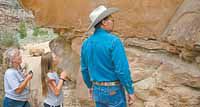| Carbon building and zoning director Dave Levanger shows the petroglyphs located neat the Great Hunt Panel in Cottonwood Canyon to Loretta and Dominique Perez of Los Angeles, Calif. The two decided to visit Nine Mile area after hearing about the rock art displays in the canyon. |
The potential impact dust from Nine Mile traffic could have on ancient markings in the canyon have concerned archeologists, rock art enthusiasts and local residents for years.
Until recently, little was done to resolve the issue. But with guidance from the Nine Mile Advisory Committee and money from Bill Barrett Corporation, at least one of the panels is better off than site has been for decades.
Two weeks ago, rocks were moved into place to block the old road up Cottonwood Canyon and reroute traffic onto a byway created on Utah School Institutional Trust Land to protect the Great Hunt Panel.
The site, formerly known as the Cottonwood Panel, was located within about three feet of the old road. Now, a large boulder shields the panel from traffic, providing visitors with a place to sit and view the site.
Additional plans are also in the offing. A landscape architect from Utah State University has submitted preliminary drawings to the advisory board and volunteers are being lined up to help create the vision. A parking area has been created at the end of the closed off road. Eventually, the board hopes to place a pavilion with information, picnic tables and restrooms in the area.
“There are a lot of good things happening in the canyon – a lot of positive things,” pointed out Carbon Commissioner Steve Burge. “There has been so much negative press about things that are going there that it obscures the fact we are moving positively in many areas.”
Burge was referring to national press articles about how gas exploration and development could damage the artifacts. The recent release of information about the Range Creek Ranch sale has added fuel to the fire.
“The money for this project was put up by Barrett, the one exploring for gas there,” added Burge. “This is a positive thing.”
The media frenzy may be creating a small boom for Carbon County. Regular canyon users have indicated that tourist interest and visitation have increased since articles appeared in newspapers like the New York Times.
“I can’t believe the tourists I have seen up here as we travel on county business,” noted county building and zoning director Dave Levanger. “There are people from all over the place and more of them all the time.”
On Friday, local residents and officials touring Nine Mile found a significant number of visitors from different states in the canyon looking for rock art and ancient sites.
Many of the visitors indicated that they heard about the canyon’s treasures from various media sources.
However, some of the people were not sure what they were looking for as they drove up and down the canyon roads last week.
The roads had been treated to control dust in the canyon by Barrett and other property users in the Nine Mile area.
At a recent advisory board meeting, the members discussed the options for Nine Mile Canyon.
“One of the things that probably need to be a priority is putting in the restrooms at the site,” stated Burge during the meeting. “I think that we will soon be seeing buses of people coming in to that area.”
Part of the draw and the resulting publicity come from a decision recently issued by the National Trust for Historic Preservation to place the canyon on the organization’s 11 most endangered places.
“I made a call to them after the fact and talked to them about who they are and what they can do to help us,” pointed out Burge at the board meeting. “I have been told that they have grants we can apply for that we can use for planning and educational purposes. However, they have no money for bricks and mortar kinds of projects.”
Advisory board and Nine Mile Coalition member Steve Tanner said the NTHP director Aimee Cole had been contacted by local individuals. The director voiced an interest in talking with the board.
“She’s excited to come out here, meet with us and straighten things out,” said Tanner.
Pam Miller from the College of Eastern Utah Prehistoric Museum pointed out that good things could come from the nomination and designation.
“In the nomination, there are solutions to some of the problems in the canyon,” said Miller. “I think that could be positive.”
Some board members have adopted a wait and see attitude about the situation, however.
“I would really like to know more about what they are about,” said board member Jim Huffaker.
Cole has tentatively agreed to come to Price for next month’s advisory board meeting.
Meanwhile, work in the canyon continues. After spending more than $30,000 to move the road in Cottonwood Canyon, Barrett is preparing to move the old Wasatch Company’s compressor station to an area near Rasmussen Cave.
Moving the compressor station will reduce the noise in the canyon and, with reclamation, will remove what many canyon supporters consider an eye sore created many years ago.
In the fall, a public lands day will be slated in the canyon and work in the Great Hunt Panel area will be finished.
“I think we need to cut a ribbon or something that day to celebrate what is going on up there,” stated Burge.

